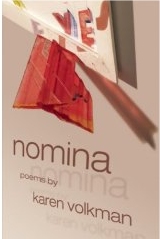

Reviews
Nomina
by Karen Volkman
 Nomina
Nomina
by Karen Volkman
BOA Editions, 2008; 71 pages; $16.00
ISBN 978-1-934414-06-4, paper
by Kristina Marie Darling
In her most recent volume of poems, Nomina, Karen Volkman pairs formalism with unwilling brides, "the wind's white hair," and the movements of stars, setting the stage for an astute meditation on the idea of chance. Written as a book-length series of sonnets, Nomina invokes astral imagery when describing the intersection of love and fate, using form to echo this delineated "sky we bear on our shoulders." In doing so, Volkman's poems present the traditions of Dante and Dickinson alongside their possibilities for twenty-first century poetry, a combination that "blazes" and "radiates" throughout.
Volkman's use of astronomy in depicting the Petrarchan theme of flight and pursuit is particularly striking. Often presenting the "paltry pretty" bride as heroine rather than beloved, Nomina depicts her betrothal through metaphors of orbits and eclipses, marriage being a metaphor that shifts meanings throughout the book. These themes are exemplified by the poem "Blank bride of the hour":
Blank bride of the hour, occluded thought
wed to waning like a sifting scent
of future flowers, retrograde intent
backwards blooming as a nascent nought
staining minutes, rumorous, uncaught.
Invoking phases of the moon as an emblem for the bride's future after being wed, Volkman uses such imagery to convey the inevitability of both commitments and one's efforts to escape them. Just as this bride's "backwards blooming" reflects a freer life before matrimony, the waning moon and retrograde orbits in the poem echo her deterioration afterward. Like many of the poems in this volume, "Blank bride of the hour" combines traditional rhyme, meter, and structure with a contemporary outlook on gender roles as well as stylistic choices, suggesting new possibilities for poetic technique.
Volkman's use of these motifs in structuring the book proves equally notable. While she begins the book with such phrases as "axis of ardor," love's "fractal ways," and its "integral of chance," the book subtly works toward a sense of resolution with this idea of fate, dazzling the reader with evocative imagery all the while. "Lifting wither," the final poem in the collection, exemplifies this trend:
Lend the daylight crescent, circle, spume,
ether from your eye, appalled perfume,
ash incense to boundary when you drift
bluely looming—motion will be mute
season spooling its argent errant thread
endless loop and lavish as the dead
note resounding a transparent flute.
Tell the boys we're leaving—wind as red
event left at the altar—the bride is fled.
Juxtaposing the "daylight crescent" moon and the cycle of the seasons with images of the errant bride, Volkman leaves readers with an ambiguous stance on "the cold sky" and its role in determining one's path. Although ending with readers drifting "bluely looming" in a liminal space, the piece suggests that the bride's having escaped pursuit by the end of the poem remains impermanent. Wonderfully complex in its treatment of literary traditions, "Lifting wither," like other poems in Nomina, proves a graceful meditation on the possibilities of time-honored poetic forms.
Kristina Marie Darling is a graduate of Washington University in St. Louis. She is the author of five chapbooks, which include Fevers and Clocks (March Street Press, 2006) and The Traffic in Women (Dancing Girl Press, 2006). A Pushcart Prize nominee in 2006, her poems, reviews, and essays have appeared or are forthcoming in many journals, which include Janus Head, Rattle, The Mid-America Poetry Review, Rain Taxi, The Adirondack Review, The Main Street Rag, Tarpaulin Sky, CutBank, The Mid-American Review, Jacket, Redactions: Poetry and Poetics and others. Recent awards include residencies from the Centrum Foundation and the Mary Anderson Center for the Arts.